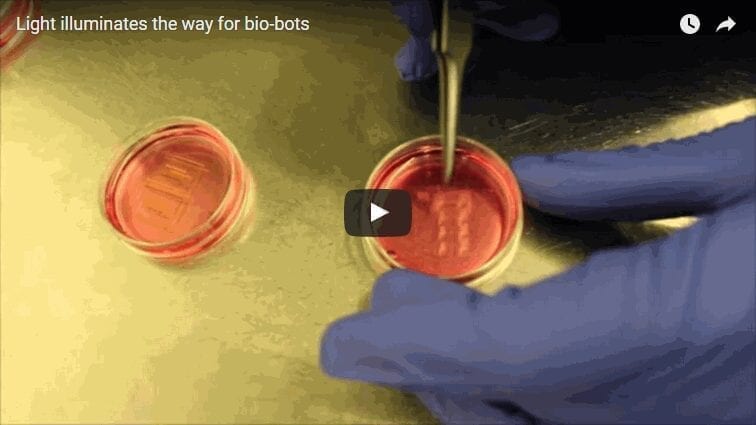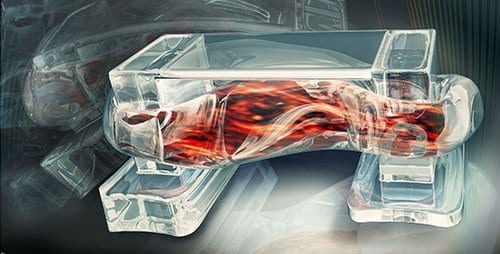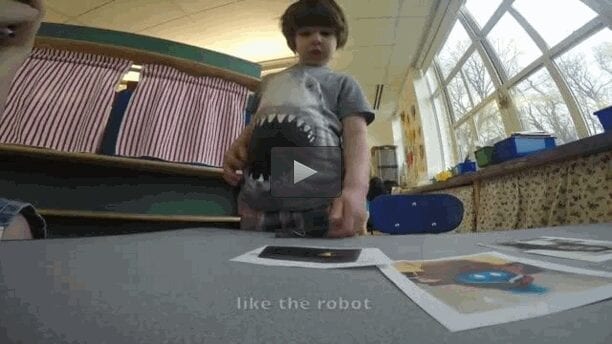
A new class of miniature biological robots, or bio-bots, has seen the light – and is following where the light shines.
The bio-bots are powered by muscle cells that have been genetically engineered to respond to light, giving researchers control over the bots’ motion, a key step toward their use in applications for health, sensing and the environment. Led by Rashid Bashir, the University of Illinois head of bioengineering, the researchers published their results in the Proceedings of the National Academy of Sciences.
“Light is a noninvasive way to control these machines,” Bashir said. “It gives us flexibility in the design and the motion. The bottom line of what we are trying to accomplish is the forward design of biological systems, and we think the light control is an important step toward that.”
Bashir’s group previously demonstrated bio-bots that were activated with an electrical field, but electricity can cause adverse side effects to a biological environment and does not allow for selective stimulation of distinct regions of muscle to steer the bio-bot, Bashir said. The new light-stimulation technique is less invasive and allows the researchers to steer the bio-bots in different directions. The bio-bots turn and walk toward the light stimulus, Bashir said.
The researchers begin by growing rings of muscle tissue from a mouse cell line. The muscle cells have a gene added so that a certain wavelength of blue light stimulates the muscle to contract, a technique called optogenetics. The rings are looped around posts on 3-D-printed flexible backbones, ranging from about 7 millimeters to 2 centimeters in length.
“The skeletal muscle rings we engineer are shaped like rings or rubber bands because we want them to be modular,” said graduate student Ritu Raman, the first author of the paper. “This means we can treat them as building blocks that can be combined with any 3-D-printed skeleton to make bio-bots for a variety of different applications.”
In addition to the modular design, the thin muscle rings have the advantages of allowing light and nutrients to diffuse into the tissue from all sides. This contrasts with earlier bio-bot designs, which used a thick strip of muscle tissue grown around the skeleton.
The researchers tried skeletons of a variety of sizes and shapes to find which configurations generated the most net motion. They also exercised the muscle rings daily, triggering the muscle with a flashing light, to make them stronger so that the bots moved farther with each contraction.
“This is a much more flexible design,” Bashir said. “With the rings, we can connect any two joints or hinges on the 3-D-printed skeleton. We can have multiple legs and multiple rings. With the light, we can control which direction things move. People can now use this to build higher-order systems.”
Learn more: Light illuminates the way for bio-bots
The Latest on: Bio-bots
[google_news title=”” keyword=”bio-bots” num_posts=”10″ blurb_length=”0″ show_thumb=”left”]
via Google News
The Latest on: Bio-bots
- Robot caterpillar can twist and crawlon May 7, 2024 at 3:39 am
An origami form called a Kreslin pattern was used to build the robot caterpillar, allowing each segment to twist into a flattened disk and expand back into a cylinder. This twisting and expanding ...
- These astonishing biobots can help neurons regrow — but researchers have no idea howon May 7, 2024 at 12:57 am
Using a patient's own cells to construct biobots reduces the risk of triggering an immune response or needing immunosuppressants, the authors said. Anthrobots last between 45 and 60 days before ...
- Biotechnology articles from across Nature Portfolioon May 6, 2024 at 4:59 pm
Biotechnology is a broad discipline in which biological processes, organisms, cells or cellular components are exploited to develop new technologies. New tools and products developed by ...
- Biophotonics articles from across Nature Portfolioon May 5, 2024 at 5:00 pm
Biophotonics is the study of optical processes in biological systems, both those that occur naturally and in bioengineered materials. A particularly important aspect of this field is imaging and ...
- Best Crypto Trading Bots in May 2024on May 1, 2024 at 5:00 pm
Take your crypto trading to the next level with the help of these highly efficient and reliable crypto trading bots. The crypto market is constantly changing with new digital currencies and price ...
- Scientists Build Biological Robots From Human Cellson December 2, 2023 at 5:02 am
So far, the bio-bots have only been able to perform these feats in a laboratory setting — just a petri dish, in fact — but their potential is no doubt astounding. The work follows up previous ...
- Self-replicating xenobotson November 30, 2021 at 9:00 pm
Ultimately, they could even help us create biobots from our own cells which could possibly be used in the body to remove the need for surgery. That does sound pretty cool, right enough.
- Self-replicating xenobotson November 30, 2021 at 9:00 pm
Ultimately, they could even help us create biobots from our own cells which could possibly be used in the body to remove the need for surgery. That does sound pretty cool, right enough.
- Melding Living Tissue and a Plastic Bodyon June 15, 2017 at 11:11 am
Why even create biobots in the first place? Because they can interact safely with humans and the environment, said Victoria Webster-Wood, PhD (CWR ’12; GRS ’13, GRS ’17, mechanical engineering), who ...
- An Inside Glimpse At How Business Development at an Accelerator Workson June 29, 2016 at 6:44 am
Our portfolio includes 250+ breakthrough technology companies and disruptive software platforms across multiple industries, ranging from household names like SeatGeek to complete industry game ...
via Bing News











